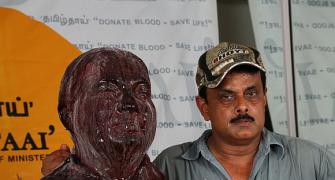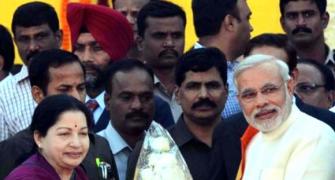Inscrutable have been the ways of Tamil Nadu Chief Minister J Jayalalithaa. She is a political strategist and tactician rolled into one that her unpredictable ways have won the day for her – mostly, says N Sathiya Moorthy
 Tamil Nadu Chief Minister and ruling AIADMK supremo Jayalalithaa released the party’s list of candidates for all 40 Lok Sabha seats in the region, including one for the Union Territory of Puducherry, on her 66th birthday on Monday. Even as rival party leaders were purportedly groping in the dark about alliance-formation, she announced her decision to launch her poll campaign from the northern temple-town of Kancheepuram from March 3.
Tamil Nadu Chief Minister and ruling AIADMK supremo Jayalalithaa released the party’s list of candidates for all 40 Lok Sabha seats in the region, including one for the Union Territory of Puducherry, on her 66th birthday on Monday. Even as rival party leaders were purportedly groping in the dark about alliance-formation, she announced her decision to launch her poll campaign from the northern temple-town of Kancheepuram from March 3.
The AIADMK has also participated in the two meetings of the emerging 11-member ‘Third Front’ at the national-level. At the regional-level too, Jayalalithaa met with national leaders of the Communist Party of India and the CPM, way ahead, and ‘firmed up’ electoral alliances with both. This would imply a greater role for the party in national politics.
The AIADMK has suffered the longest ‘drought’ of non-participation in the government at the Centre at the national-level ever since ‘coalition politics’ became the norm at the Centre in the Nineties. Independent of the party’s aspirations for Jayalalithaa becoming prime minister, there is an urgent need for reversing the current trend.
Yet, questions remain.
Is Jayalalithaa keeping her alliance options open? Will ‘Amma’ be reconsidering the Left Front alliance in favour of an electorally more-productive pre-poll tie-up with the BJP?The delayed decision on the AIADMK part on seat-sharing talks with the two communist parties has been a cause for concern for the both. Worse still, it could be embarrassing for their national leaders, if such a thing were to happen after they had queued up before Jayalalithaa’s Poes Garden residence for firming up the alliance in the state.
For the two Left parties, Tamil Nadu is possibly the only state other than their traditional strongholds of Kerala, Tripura and West Bengal, to be able to hope for winning Lok Sabha seats. Their seat-share, both in alliance formation and poll victories are entirely disproportionate to the near-non-existing vote-share.
Barring a series of talks with the AIADMK, the two Left parties have nothing concrete on hand to show that they will get seats (and of their respective choice) to contest in the AIADMK’s company.
Yet, inscrutable have been the ways of Jayalalithaa, the political strategist and tactician rolled into one that her unpredictable ways have won the day for her – mostly.
First, the signals:
Though not unprecedented, Jayalalithaa told newsmen on her birthday that the party would withdraw its candidates once seat-sharing talks with the two Left parties are completed.
Two, for the past three weeks or so, AIADMK second-line leaders and platform speakers have stopped referring to Jayalalithaa as the ‘next prime minister’ of the country.
There are valid explanations -- and equally valid arguments against them.
In the past, the AIADMK under Jayalaithaa had made changes to its candidates’ list at the last-minute, both owing to inner-party hassles, and at times to accommodate allies, whose feathers may have been ruffled, first for not concluding seat-sharing talks with them in advance.
AIADMK second-line leaders and platform speakers stopping all references to Jayalalithaa as the ‘next prime minister’ started possibly after her separate meetings with CPI’s A B Bardhan and CPM’s Prakash Karat. After these meetings, Jayalalithaa told waiting newsmen that the ‘Third Front’ prime ministerial candidate could be finalised after the LS poll results were known. Karat cited Jayalalithaa’s declaration after this week’s Third Front meeting in Delhi.
What then is the hassle? Or, what are the causes for doubting the AIADMK’s current moves?
Though Jayalalithaa’s master-stroke (of declaring freedom for seven Rajiv Gandhi assassins after the Supreme Court had commuted the death sentence against three to life-terms without any loss of time) may have ‘delayed’ the DMK and the Congress coming together, no one is sure that it would stay that way.
If anything , the state government’s hurried decision, as different from the Supreme Court’s decision, may have revived memories of the assassination in the minds of the older generation, and questioned their own rationale for sympathising with ‘Rajiv Gandhi killers’ in the mind of younger voters in the State.
Questions still remain on a DMK-Congress tie-up, starting with Stalin’s public reservations and the DMK’s General Council decision not to tie-up with the Congress, taken late last year and sort of endorsed at their 10th State Conference in Tiruchi, later – yet keeping the Congress option open.
For his part, Vijaykant is in no hurry to conclude an alliance. He has been talking to every political party in turn or at times simultaneously, for the past so many months. With Vijaykant away in Singapore with confidante-cum-wife Premalatha, media reports asserted that his team was negotiating with the BJP back home.
The buzz-word is that DMK patriarch M Karunanidhi has not lost his celebrated touch for doing the unthinkable, some of which Vijaykant too seems to possess on his own. It is rumoured that the DMK, DMDK and the Congress will wait until after the Election Commission had announced the polling dates before firming up – and announcing – their alliance for Tamil Nadu and Puducherry.
True or not, back-of-the-envelope calculations of a strong DMK-led alliance have made the AIADMK second-line thinking. Going by past poll figures, the AIADMK may then face a formidable alliance, and the two Left parties would be no match for the combined strength of the DMDK and the Congress, relatively smaller both than the near-equal strengths of the two ‘Dravidian majors’.
Much as the AIADMK would want to continue with the Left alliance.
The AIADMK would need to share the electoral spoils of the ‘Modi factor’, if not an outright ‘Modi wave’, which can be felt across the state anyway.
Going by the dictum of the Dravidian political patriarch the late C N Annadurai, “There cannot be two swords in the same shield.” The AIADMK cannot have prime ministerial ambitions for Jayalalithaa and hope to align with the BJP, for whose NDA as a whole, Narendra Modi is the poll mascot.
It is not unlikely that the Congress might still be forced to go it alone – and face an LS poll as disastrous as those in 1998 in recent years. Not tired of speculating on alliance-formations, the local media has already said that the PMK, for instance, may be open to an alliance with the Congress.
That could make a Congress-PMK combine a fourth option before the State’s voters, particularly in the northern Vanniar-belt, where the PMK has a strong presence in close to 20 of the 40 parliamentary constituencies.
Yes, already media imagination has gone back to the past weeks when there were Modi-friendly comments by DMK’s Karunanidhi, which did not find the right resonance from the BJP.
With or without the DMDK, Stalin alone may not be able to sway the party away from keeping the Congress ‘untouchable’ for too long. With the DMDK, it is about the DMK combine hoping to win the polls comfortably. With Congress too on the DMK bandwagon, it is about sweeping the same.
Plus-Congress, minus the DMDK, again there is a fighting chance, with a strong(er) BJP combine, and possible nominees of the Aam Aadmi Party hopefully cutting into traditional anti-DMK vote-share that would have gone mostly to the AIADMK, otherwise.
An AIADMK-BJP alliance and a Modi-Jaya road-show would be a formidable combine, even the clincher. For the BJP, the national-level dividend would be as much as what it was in the Nineties, when AIADMK became the first substantial regional ally to endorse Atal Bihari Vajpayee for prime ministership.
The AIADMK would (have to) consider the BJP option only if it is faced with a formidable alliance, as it perceives. The risks for 2016 are huge, in its calculations, too.
But today, the question is this: Who will blink first, when, how and how long?
The question is also this: Would the BJP want to respond to any last-minute overtures from the AIADMK for an alliance? If so, what are the poll-time and post-poll consequences for the party’s policy-positions on some of the issues highlighted in the AIADMK manifesto?
The BJP would then face another problem, too – one that involves the party’s ‘credibility’ as a dependable ally and alliance leader. Could BJP’s prime ministerial candidate and current decision-maker, Narendra Modi, afford to be seen as compromising on the BJP’s famed ‘coalition dharma’ even before he had started off?
Still the largest question of ‘em all is reserved for the post-poll scenario: With the AIADMK-Left Front combine continuing now, and a DMK alliance with the Congress shaping up, too, what if there is a post-poll Third Front government at the Centre, but having to depend on the Congress for ‘outside support’?
N Sathiya Moorthy, veteran journalist and political analyst, is at present Director of the Chennai Chapter of the Observer Research Foundation









